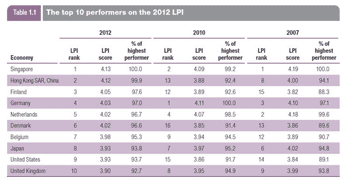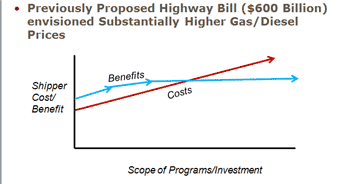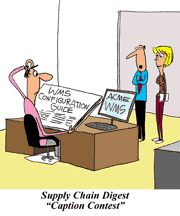 |
June 13, 2013 - Supply Chain Newsletter |
 |
| FEATURED SPONSOR: LOGILITY |
 |
Download this White Paper Outlines a Five-Step Approach for Optimizing the Core Tasks and Analyses that Drive S&OP Results |
 |
|
||||||||||||||||||||||||||||||||||||||||||||||||||||||||||||||||||||||||
US Logistics Infrastructure Paradox
|
|||||||||||||||||||||||||||||||||||||||||||||||||||||||||||||||||||||||||
| GILMORE SAYS: |
"My take in the end: we have some issues, like everyone else, but much of the rhetoric is overblown." WHAT DO YOU SAY? |
So as they do every few years, the American Society of Civil Engineers released its infrastructure report card earlier this year, and as usual the results were said to be dire.
The US overall received a grade of D+, and the ASCE says $3.6 trillion beyond what we spend now will be needed to close the gaps. That, of course, is a pipe dream.
That overall near failing grade includes some categories that aren't logistics related, such as drinking water and parks and recreation, but in general the results are similar across categories, with the exception of solid waste handling infrastructure, which received a B+.
For the logistics related areas, grades were as follows: Roads: D, Rail lines: C+, Ports: C, Inland Waterways: D
I did not include Bridges in that list because I am not sure if they really belong, but if you are interested they received a C+ (a higher grade than I would have guessed).
With regard to roads, the report says that "Forty-two percent of America's major urban highways remain congested, costing the economy an estimated $101 billion in wasted time and fuel annually. While the conditions have improved in the near term, and Federal, state, and local capital investments increased to $91 billion annually, that level of investment is insufficient and still projected to result in a decline in conditions and performance in the long term."
Yet, it is very rare to hear a supply chain or logistics executive really complain about US logistics infrastructure, or name it as a high priority for action. Is that because it just isn't a high priority, or because addressing the issue is so far out of an individual or company's control that it isn't worth wasting the time?
In the semi-annual Logistics Performance Index rankings from the World Bank, the US came in in ninth place overall in 2012 across the six categories rated. Perhaps surprising to most given the hue and cry, the US placed a strong fourth in terms of infrastructure. Here is a graphic of the top 10 rates countries, by the way, based on a massive survey of freight forwarders.

Source: World Bank
View Full Size Image
So which side is right?
It's probably a little of both. The US interstate highway system overall is superb. The rail carriers themselves are investing billions and billions to add track and improve terminals, control software and more. The major US rail carriers will spend more than $14 billion in capital investments in 2013, up from about $13 billion in 2012 and more than twice the $6 billion or so a decade ago. The ASCE report says rail carriers are investing about 40% of revenues back into their networks.
Clearly there is a lot of congestion in and around major cities - but this is a global phenomenon that is probably a permanent condition everywhere. And many are now saying building more roads and lanes is not likely to have much of a real impact.
And while improving, US ports have a lot to be desired in terms of efficiency versus major ports in Asia and Europe. An executive at APM Terminal, a division of AP Moller-Maersk, said its terminal in Yokohoma Japan completes about 48 crane moves per hour, versus just 25 or so for APM's terminal at Port Elizabeth in New Jersey. But I suspect this is mostly a reflection of automation and the state of labor contracts here versus there, not some US deficiency in government port investment.
Certainly, many US ports need to make changes to handle the larger megaships that are coming to market and will be arriving after the expanded Panama Canal is opened, but that seems to be happening with funding at the state level, where they smartly recognize it's a matter of dredge or die.
One challenge I have found is that, given all the money everyone says we need isn't going to be found, the logistics industry has not been very clear about what the priorities should be. I have asked both UPS and FedEx this question in the past, and either receive no response, or a response along the lines of "we just need a unified plan, and one pool of money, rather that different government pools across roads, ports, rail, etc."
My take is that the American Trucking Associations considers the infrastructure issue an important but not critical one. But I will note that one of the better statements on what the priorities for investment should be came from Derek Leathers, COO of trucking firm of Werner Enterprises, who as quoted on the ATA's web site told the House Transportation and Infrastructure Committee in April that the focus should be on reducing or eliminating bottlenecks in the interstate highway system and intermodal freight connections.
So that makes some sense. Let's identify where there are real bottlenecks and prioritize investment there, though I am not sure why the government and not rail lines and truckers can't make their own investments in better intermodal facilities.
And as I have done before, I will note that carriers and shippers have to be careful in what they wish for. The money for infrastructure improvements has to come from somewhere, and in the end that will be shippers and regular drivers, through gas taxes, tolls and maybe soon things like vehicle mileage taxes.
There has to be a diminishing curve in terms of benefits to those higher costs, as shown in the simple graphic below.

I don't know where that intersection point is, but it's out there.
My take in the end: we have some issues, like everyone else, but much of the rhetoric is overblown. The industry should identify the real bottlenecks in some kind of rank order. The US inland waterway system does need a lot of investment, but if we build it will anyone really come? The railroads seem to be taking care of themselves. Congestion in US cities, like everywhere else, is a real problem, but if it is fixed at all it will likely be through congestion taxes, requiring deliveries at night, innovative distribution approaches, etc., not more infrastructure. And D is far too low a grade.
What is your perspective on US logistics infrastructure? Good, terrible, or in-between? Where do you think the investments priorities should be? Let us know your thoughts at the Feedback button below.
![]()
| View Web/Printable Version of this Page |
|
|
|
YOUR FEEDBACK
Received a number of letters from our First Thoughts column last week on Supply Chain Future - A Physical Internet?
We publish a few of those below, including our Feedback of the Week from John Hill of St Onge, who provides some context on how the whole idea was started.
Feedback of the Week - The Physical Internet:
The roots for the PI initiative can be traced to MHI's 2007 Material Handling Logistics Summit and a proposal for concept refinement funding presented to MHI & CICMHE by Drs. Russ Meller and Benoit Montreuil (Universite Laval, Quebec) in 2010. An excerpt from the proposal: The 2007 Material Handling Logistics Summit was a defining moment for CICMHE, MHIA and all of the Summit participants. In fact, the foundation for the proposed research can be traced back to this event. One of the summary themes of the Summit was, Theme 4: Vision and roadmap for next-generation supply chains and associated Material Handling & Logistics innovation challenges, steering key projects. We present a proposal that directly addresses this theme and one of its associated initiatives, Develop a vision and models for future supply chains by exploring intra-facility and inter- facility issues, identify gaps in state-of-the-art and knowledge, and generate a research and development roadmap, perhaps through a think tank. As will be shown in our proposal, we have developed such a vision, proposed models related to this effort, and identified a group of industrial collaborators that will, along with the principal investigators and other researchers, seed the think tank. I offer this bit of information not only to recognize the early sponsors (MHI, CICMHE, CELDI) and pioneers (Ellis, Meller, Montreuil and those currently helping them), but also to assure that when the history of the Physical Internet is written (and it will be) that its origins are not obfuscated by faded memories. Along similar lines, keep an eye on what MHI and other organizations are doing in support of development of a US Roadmap for Material Handling & Logistics. Neither the PI nor the Roadmap will be a short term initiative, but it's good to see private industry and academia collaborating today on solutions that will enhance the contributions the supply chain community can bring to the quality of life for future generations. John Hill |
||
| More on Physical Internet: | ||
Your article on the Physical Internet syncs with a lot of activities going on this space under various names including internet of things, real-time supply chains,... So you were not late in your report. Good things happen in Nine months!! Amazon just announced their same day delivery of groceries. Walmart has been at it in some cities. A lot of technologies including RFID, GPS, OCR have come in waves and left varying experiences with the early adopters. It is the second wave now that is leveraging the lessons learnt with a more educated customer deploying tactical solutions with tangible benefits. The Quebec-to-LA example raises a lot of basic questions on the need to rethink the solutions and address new demands for how same-day-deliveries will be accomplished by supply chains. It is a great time for the American economy and innovators to rethink the value of every supply chain link. Subhash Chowdary |
||
I think this would work. Container modularization changed the world of shipping when standards were agreed, but it took a visionary like Malcolm McLean to take the risk, invest and lead change. In today's opinionated, open to anything environment, I think that human aspect of being able to agree to a standard will be the obstacle. After all, there plenty of technical solutions to most of the problems we face nowadays, reaching consensus is not just an issue in Washington. Of course, back to basics, as with a pallet, chassis or container, who will be responsible for the cost to replace the damaged modular unit? Eugene V. Nusekabel |
SUPPLY CHAIN TRIVIA ANSWER
Q: Name the top 5 global 3PLs in terms of revenue for 2012, according to the latest Armstrong & Associates report.
A: (1) DHL (2) Kuehne + Nagel (3) Nippon Express (4) CH Robinson (5) Hyundai GLOVIS.
| © SupplyChainDigest™ 2003-2013. All Rights Reserved. SupplyChainDigest PO Box 714 Springboro, Ohio 45066 |
POWERED BY: XDIMENSION
|









